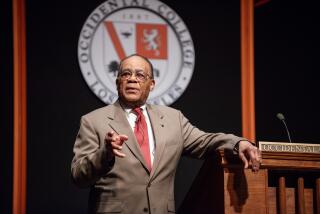John Pierce, 92; Engineer, Inventor, Teacher, Author
- Share via
John Robinson Pierce, a multifaceted electrical engineer with a flair for words, has died. He was 92.
Pierce, who spent the past two years in an assisted-living facility in Sunnyvale, Calif., died Tuesday in a Mountain View hospital of pneumonia.
Pierce named the ubiquitous transistor, fathered the communications satellite, and became an expert on computer music and musical acoustics--and wrote about all of it, sometimes in entertaining science fiction format.
The inventive engineer held some 90 patents, wrote or co-wrote more than 20 books and 300 scholarly papers, and--under the pseudonym J.J. Coupling--published more than two dozen science fiction short stories in magazines such as Fantasy, Science Fiction and Penthouse.
His thoughtfully named “transistor,” which replaced cumbersome vacuum tubes and forms the core of missiles, heart pacemakers, blenders, compact disc players, televisions, the telephone system and computers, among other things, was invented in 1947 by three of Pierce’s colleagues, who shared a Nobel Prize in physics for the effort in 1956--William Shockley, John Bardeen and Walter Brattain.
Like Pierce, they all worked for Bell Telephone Laboratories in Murray Hill, N.J., and Brattain, knowing Pierce’s talents as a wordsmith, asked him what to call their little miracle. (The trio had dubbed the gizmo the “persistor” for their own persistence in perfecting it.)
“It was supposed to be the dual of the vacuum tube. The vacuum tube had transconductance, so the transistor would have ‘transresistance,’” Pierce once said on the PBS “Transistorized!” program. “And the name should fit in with the names of other devices, such as varistor and thermistor. And ... I suggested the name ‘transistor.’”
Pierce earned his own greatest accolades for his work in communications satellites.
He was the major force in creating the 100-foot-diameter aluminum-coated polyester balloon called Echo I, launched by NASA on Aug. 12, 1960. Able to reflect radio waves, Echo I made possible the first coast-to-coast television transmission and stayed in orbit for eight years.
The first message, recorded by President Eisenhower, was bounced from a Jet Propulsion Laboratory antenna near Goldstone, Calif., to a Bell Labs station in New Jersey.
Pierce then set to work on Telstar I, his instrumented communications satellite that transmitted the first transatlantic TV signals and speeded phone calls around the world. It was launched July 10, 1962.
In 1985, Pierce was honored for his work on the satellites, sharing the first Japan Prize and splitting a stipend of $190,000. The prize is granted for “significant and revolutionary achievements of originality” in science and technology “for the peace and prosperity of mankind.”
Ten years later, he shared the $400,000 Charles Stark Draper Prize of the National Academy of Engineering with Harold A. Rosen, the former Hughes Aircraft Co. engineer who designed and developed Syncom II, the first satellite sent into a constant orbit of 22,300 miles in 1963.
Noted science fiction writer Arthur C. Clarke had envisioned the communications satellite in a 1945 article, and duly saluted Pierce and Rosen, calling them in 1995 “the fathers of the communications satellite.”
“They designed, developed and produced it, making real that which I and others thought only to write and dream about,” the writer said.
During his long tenure at Bell, from 1936 to 1971, Pierce also invented the Pierce Gun, a vacuum tube that transmits electrons and is still used in linear-beam microwave tubes that play a role in satellites and in powering linear accelerators.
But Pierce wasn’t through yet. After his first retirement in 1971, he spent more than a decade at his alma mater, Caltech, teaching engineering and working at JPL as chief technologist.
After a second retirement, he decided to pursue a subject that had intrigued him for decades--computer music. He became a visiting professor of music at Stanford University in 1983, and visited for 12 more years.
At Stanford, he helped secure funding for the creative study of computer music and studied psychoacoustics--the science of how people perceive sound.
His book “The Science of Musical Sound,” published in 1983 and revised in 1992, became an important textbook in the neophyte field for many years.
“This lavishly illustrated introduction to musical acoustics,” a reviewer for Science magazine wrote in 1984, “demonstrates once again the wide-ranging wisdom, infectious enthusiasm, and unique flair for rendering the complex comprehensible that John Pierce has manifested in numerous earlier scientific books (not to mention several science-fictional entertainments....).”
Titles of Pierce’s literary work over the years reflect his scientific work: “Theory and Design of Electron Beams” in 1949, “Traveling Wave Tubes” in 1950, “Electrons, Waves and Messages” in 1956, “Symbols, Signals and Noise” in 1961, “The Beginnings of Satellite Communications” in 1968, “Almost All About Waves” in 1974, “Introduction to Communication Science and Systems” in 1980, “Information Technology and Civilization” in 1984, and (with A. Michael Noll) “Signals, The Science of Telecommunications” in 1990.
Born in Des Moines in 1910, John Robinson Pierce earned bachelor’s, master’s and doctoral degrees at Caltech.
He is survived by his wife of 15 years, Brenda Woodward Pierce of Palo Alto; and a son and daughter from an earlier marriage, John and Elizabeth Pierce, both of New Jersey.
A memorial service is scheduled for 2 p.m. May 3 at Memorial Church in Palo Alto, with a reception and concert to follow at Stanford University.
Memorial donations can be sent to Stanford University for the John Pierce Memorial Fund, c/o Chris Chafe, CCRMA Music Department, Stanford, CA 94305-3076.




